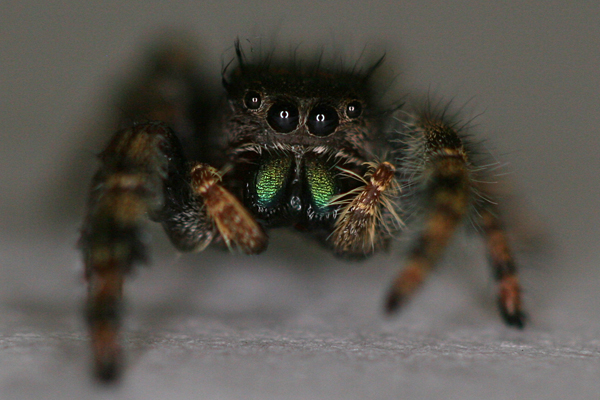A study out in today’s Science Magazine by Takashi Nagata, Mitsumasa Koyanagi, Hisao Tsukamoto, Shinjiro Saeki, Kunio Isono, Yoshinori Shichida, Fumio Tokunaga, Michiyo Kinoshita, Kentaro Arikawa and Akihisa Terakita proposes that jumping spiders at least, use image defocusing to provide depth perception. Jumping spiders (Salticidae) are the largest family of spiders and have perhaps the best visual acuity of the invertebrates.
It turns out that in addition to excellent visual acuity, jumping spiders use a previously unknown method of determining depth. The trick that humans use to judge depth is using image offset coming from each eye to then estimate depth through parallax. Fusion of the imagery occurs in the brain with the percept of seeing a single image despite two separate images being transmitted to the brain. Other animals use parallax in a different way by moving their heads to estimate distance to objects of interest. I used to have a pet octopus that would range by parallax, bobbing her head up and down before reaching out for a Lego piece, crab or carp that I would put in her tank. It was absolutely fascinating to watch.
Jumping spiders however, use an entirely different means of estimating distances that relies on spectral perception in the multi laminar principal eyes. They have 8 eyes total with the two large front facing eyes you can see in the image above being the principal eyes who’s “retinas” are organized into 4 separate photoreceptor layers, each receptive to different parts of the spectrum. The first two layers of the retinas are rod shaped and appear to be tuned to what humans perceive as the visible spectrum, particularly green light. However, its the first layer that the optics appear to focus the light on with the second layer receiving defocused light. Layers three and four are most receptive to ultraviolet light, but its the first two layers that are the subject of this paper.
The question was… why have a layer of photoreceptors that received only out of focus light? What purpose would having such a layer have as it would seem to cause visual percepts to be blurrier rather than sharper. It turns out the answer is so the animal can compare two separate realities, one with a sharp image and the other with a blurry image. The experiment was one of those experiments that is elegant in its simplicity. When using just green light to illuminate prey, the spiders were always accurate in their strikes, just light in full spectrum light. However, when green light was excluded and red light exclusively was used to illuminate prey, the spiders attacks on prey were typically short. The study also included some gene expression studies and electrophysiology in addition to the behavioral work, but the conclusion is that spiders seem to use an entirely different way of determining depth perception than previously understood. Further information into how the signals are processed still needs to be elucidated.
The image above is mine and originally appeared in a post here. But for some truly amazing imagery of jumping spiders (and other insects), see Thomas Shahan’s image stream on Flicker. I am a big fan of Thomas Shahan’s work and eagerly look forward to the next, greatest image from him.
